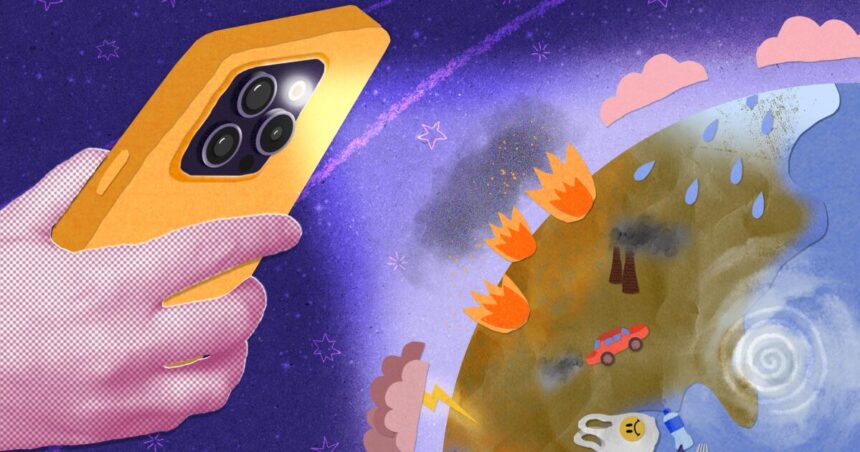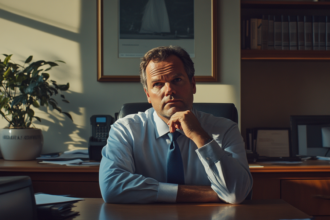Imagine this: You receive an alert about a raging wildfire burning close to home. The air keeps filling with acrid smoke and the sky turns from blue to an eerie orange.
Or maybe you hear about a massive coal ash spill a few hours away from home, but you have no idea how to respond.
Or, as you repeatedly see news headlines about melting ice sheets and hear that the Arctic may be ice-free by 2050, you find yourself wondering whether you’ll outlive a polar bear.
And when they need more information, where do they turn? Young people are increasingly using social media as their primary news source: one study found that 56% of 14-18 year olds learn about climate change from apps like TikTok, YouTube and Instagram, where young activists are sounding the alarm and calling for action.
For example, the impacts of climate change hit home as a high school senior when California experienced its worst wildfire season on record in 2018. Now, at 22, she serves as executive director of , an organization that uses TikTok to empower young people to influence national climate policy.
The 22-year-old Mexican-born Indigenous activist grew up hearing the words “climate change.” At 17, she co-organized a climate march in New York City, taking her first steps toward becoming a leading Indigenous advocate in climate policy. She is now the executive director of the Re-Earth Initiative, which focuses on the intersectionality of the climate crisis and has a strong presence on Instagram.
Bastida and Joshi don’t see themselves as content creators – they’re activists who post on social media to get their message out.
Her path to activism took a different direction. After college, she worked at a solid waste treatment facility and then at a local government agency drafting environmental plans and grants. When state budget cuts eliminated her job in East Tennessee, she turned to being a full-time content creator, fighting misinformation on social media as the “Queen of Trash.” She accepts sponsorship and runs sponsored ads from companies that align with her environmental and political views.
These three women, like many others of their generation, emphasize the need for activism and urgency, reminding their followers that young people have much more to lose than older generations. They recognize the importance of social media and engaging with their peers wherever they are.
Elise Joshi
Joshi, who will graduate from the University of California, Berkeley in 2023, began posting during the pandemic. While researching the climate crisis, the current state of environmental policy, and the Trump administration’s rollback of protective measures, she shared statistics on TikTok, such as one in six deaths being linked to air pollution and the decline in crop yields for every degree of temperature rise. Her eighth video, which criticized then-President Trump’s COVID-19 policies and the Black Lives Matter movement, went viral, and she began to understand how to use social media as a tool.
“I was never very good at it,” Joshi said, but after four years, “I kind of figured out how to do it.”
Joshi, along with other activists and creators, joined “TikTok for Biden,” a group founded to oppose the policies of the Trump administration ahead of the 2020 election.
The organization changed its name in early 2021 to reflect its expanding scope of interests and advocacy. Gen-Z for Change currently has nearly 2 million followers on TikTok, and Joshi has more than 200,000 followers across his personal accounts.
In July 2023, a video of Joshi interrupting a White House staffer went viral and became a hot topic on the internet.
Earlier that year, the Biden administration approved the $8 billion Willow Drilling project in Alaska, which ran counter to Biden’s policy of opposing the ending of fossil fuel leasing on federal lands, infuriating environmental activists who campaigned against it.At the Young Voter Summit, Joshi let out a shaky breath, interrupting White House press secretary Karine Jean-Pierre moments after she said the administration was listening to what young voters were saying about climate change.
“Sorry to interrupt, but polite pleas haven’t worked,” Joshi said. Her voice was trembling, but she continued: “One million people wrote letters pleading with the government not to approve a disastrous oil drilling project in Alaska and were ignored. … Will the government stop approving new oil and gas projects and stand in lockstep with young people, scientists and frontline communities from Alaska’s North Slope to Louisiana?”
During the exchange, Jean-Pierre said Biden had done more to address climate change than previous presidents, and it garnered a huge audience on TikTok — Joshi said it had 30 million views and counting.
“I got emails from dads saying, ‘Actually, I don’t agree with you on the oil story, but the way you delivered it made me really proud,'” she said of the aftermath. “And I got death threats… but I think the good comments outweighed that.”
After the disruption video went viral, Joshi saw “big changes” in the Biden administration. The White House ultimately canceled seven oil and gas concessions in Alaska’s Arctic National Wildlife Refuge and pledged to protect 13 million acres of land in the western Arctic. Joshi said this wouldn’t have happened without the #StopWillow movement and young people rallying online.
“The TikTok campaign is incredibly valuable because it creates a context in which what is seemingly acceptable becomes unacceptable,” Julie See, an American studies professor at the University of California, Davis, said of the social media campaign.
“It’s sad that it comes from pressure and pleading,” Joshi said, “but not from polite conversations on Zoom.”
Focus on Bastida
Sie Bastida’s parents met at the United Nations Conference on Environment and Development in 1992, and as she was growing up, climate was a regular topic of conversation at dinners and family gatherings.
In 2015, when Bastida was 13, her hometown of San Pedro Tultepec, about 30 miles southwest of Mexico City, flooded after several years of drought. “When you start seeing that in your life, you have no choice but to act,” she said.
Bastida and her family moved to New York City, where her parents began working for the environmental group Global Ethics Center and Bastida began learning about organizing, with fewer risks than in Mexico.
By 2019, she was organizing the Fridays for Future climate demonstrations in New York City, and says she found her community in the online world, where she helped build an international coalition with other environmental activists.
Bastida, who recently graduated with a degree in environmental studies from the University of Pennsylvania, spends most of her time working with the Re-Earth Initiative.
During the UN’s annual climate change conference, Bastida will be appearing on Instagram Live to answer questions from her 85,000 followers about updates from the event. She said she understands she can play a role in influencing what people see online, especially when it comes to calling for action.
“I feel like if I had access to that space, I could share information not just with the people in the group chat, but with people who aren’t (just) interested in climate,” she said.
Bastida said social media platforms have had a positive impact on her life overall, connecting her with climate activist communities around the world – through her work she has connected with Sweden’s Greta Thunberg and Ecuador’s indigenous climate activist Helena Guaringa.
“That’s where I found my global community, and that’s how we can reach people,” she said.
Alaina Wood
When Alaina Wood was in middle school, she learned about a coal ash spill that had released toxic sludge containing arsenic and mercury into the Emory River west of Knoxville, Tennessee. It was an awakening, the first time she felt she had to take action. something.
In high school, she led a campaign to install water bottle stations on campus. At the University of Tennessee, she picked up and sorted trash left behind by 100,000 people at a football game. She has degrees in sustainability and geography and calls herself a sustainability scientist.
After graduation, Wood worked as an environmental compliance coordinator for a private landfill company and then took a position with the Tennessee First Development District, a local government group, working on solid waste management projects.
When the pandemic lockdown began, Wood joined TikTok to post “goofy” videos, but at some point her “for you” page – a curated feed for users – began to include environmental content.
“Some of them were really good and accurate,” she recalls. “Others were a bit worrying, full of misinformation or the idea that you’re not a good environmentalist unless you’re completely zero waste.”
Posting under the name “Garbage Queen,” Wood made a video about the zero-waste movement, saying it can sometimes be counterproductive, encouraging consumerism and creating more waste. The video went viral, and Wood found a community that was willing to listen to her voice.
When “climate catastrophe” started trending in the summer of 2021, she started a TikTok series called “Good Climate News,” providing a weekly roundup of research and positive news to counter the flood of doom and gloom. In four months, she gained 75,000 followers, more than the population of her hometown.
“A lot of people don’t realize the amazing progress I’m making when they read scientific studies,” she says. “I see it as my job to say, ‘Hey, I’ve found this really cool thing that you might not have noticed, and it’s not too late.'”
Wood said about 75 percent of her audience is under 40, and she feels pressured to ensure what they post online is accurate and uplifting as they vet studies, reports and stories.
When the #StopWillow campaign failed to stop a drilling project in Alaska, she worried it would lead to young people becoming apathetic, but she heard from her followers that watching her videos had inspired them to pursue careers as environmental activists.
“My audience is so young and I’ve been so nervous about how things will be received. They’re so insecure right now,” she said. “If I say something wrong, I could send someone into a panic. But if I say something right, I can keep them engaged.”









